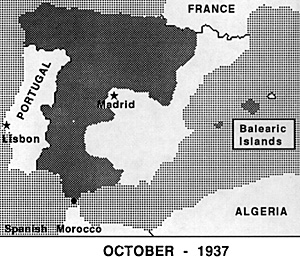
Foreign Troops in the Nationalist Army
The most important groups of foreigners were the German Condor Legion and the Italian Corpo di Truppi Voluntari. The German contribution was very small in terms of ground troops, initially one tank group of 48 PZK I's and a motorized flak unit of five heavy 88mm FLAK 18s batteries and two batteries of 20mm FLAK 20s. Soon the tanks were crewed by Spanish personnel, with command remaining German. In 1938, the German command was replaced and the unit was absorbed into the Agrupacion de Carros del Norte. By the end of the war, the only purely German ground formation was the regiment of 88s.
The significant German contribution was in the area of instructors, communications equipment, technical services, and, most importantly, pilots and ground crew for the large German air contingent operating in Spain from January 1937 through the end of the conflict. The German contingent in Spain hovered between 5,000 to 6,000 throughout the war. In total, about 15,000 Germans served in Spain, the majority of them aviation personnel.
The Italian contribution, in contrast to the German, consisted of large numbers of ground combat troops in addition to a sizable air contingent and the activities of Italian navy units. Italy's dictator Mussolini wanted to replace the Spanish Republic with a government under his influence. Mussolini was also deeply interested in the prestige to be gained by Italian participation in the civil war and insisted that his troops be used for important attacks and en masse only. Ultimately, over 80,000 Italians would serve on the side of the Nationalists, about 6,000 of these being air force personnel.
The Corpo di Truppi Voluntari (CTV) was a full army corps complete with supporting arms. Given the generally dismal performance of the Italian Army in World War 11, the contribution of the CTV has been belittled. It was, however, of great assistance to Franco, providing trained and well-equipped (by Spanish standards) troops in the crucial period of early 1937.
The CTV stayed at a strength of four small divisions with artillery, assault engineer and light tank support from February 1937 throughout the war. The level of motorization in the CTV was higher than in the Spanish Army, although its equipment was largely the same as that supplied by Italy to the Spanish. As the war progressed, an increasingly large percentage of the infantry of the CTV was Spanish, usually drawn from the Falangist militia. By the end of the war in March 1939, only one division was entirely Italian. The other three were of mixed composition with Italian command and technical troops and Spaniards in the front line. All of these mixed units had names that incorporated the word arrows (Flechas in Spanish, Freccia in Italian), the arrow being a common Fascist symbol.
Of the four original divisions of the CTV, three (1 Dio lo Vuole, 2 Fiamme Nere, 3 Penne N e re), were made up of Fascist party troops, Carnicia Nere, or Black Shirts. Each of these was made up of three groups of three battalions, each group consisting of a battery of 65mm infantry guns. Each division had in its divisional artillery regiment 12/75mm guns and 16/100mm howitzers. There was also an independent brigade of Black Shirts (23 Marzo). The fourth division (4 Littorio) was made up of Italian army personnel and was organized like the binary divisions of the Italian army, two three-battalion regiments each with an infantry gun battery and a machine gun battalion.
The divisional artillery regiment consisted of 24/65mm guns and 16/100mm howitzers. The CTV also had a tank regiment with four companies of tankettes, one company of armored cars, and a motorcycle company. For corps artillery assets there were 24f75mm guns, 32/100mm howitzers, 12/105mm guns, and 24/149mm howitzers. The two mixed brigades (Flechas Negras and Flechas Azules) had two three-battalion regiments and a grupo of 12/75mm guns.
After the disastrous battle of Guadalajara in March 1937, the Italian part of the CTV was reorganized into three divisions of mixed army and black shirt personnel (Fiamme Nere, 23 Marzo, and Littorio), all organized like Italian army divisions. The tank unit now had motorized infantry battalion, and the motorcycle company had been expanded to a battalion. CTV engineer assets also included a company of flamethrower tanks. By early 1938, the mixed brigades were combined into a division (Flechas) with 13 battalions of infantry, 36/75mm guns, and two batteries of German 37mm AT guns.
After various changes, the final configuration of the CTV was of one Italian division (Littorio d'Assalto) and three mixed divisions (Flechas Negras, Flechas Azules, and Flechas Verdes.) Littorio d'Asalto had two regiments of four battalions each, an arditi (assault) battalion, a mortar battalion, and an artillery regiment. Each of the mixed divisions had two three-battalion infantry regiments and a heavy weapons (mortar and machine gun) battalion. Their artillery regiments consisted of 24[75mm guns and 12/100mm howitzers.
About 10,000 Portuguese served in the Nationalist Army, many of them in the Foreign Legion. The Portuguese government sent all sorts of assistance to Franco including Portuguese military personnel, railroad rolling stock, and ammunition. The Foreign Legion, incidentally, was about 90 percent Spanish at the beginning of the war; the proportion of foreigners stayed about the same throughout the war. There was a French company and an Irish bandera. About 85,000 colonial troops served in the Nationalist Army, the vast majority of them Moroccan. These were very important to the Nationalists early in the war.
Franco's Armed Forces Spanish Civil War
Back to Europa Number 14 Table of Contents
Back to Europa List of Issues
Back to MagWeb Master Magazine List
© Copyright 1990 by GR/D
This article appears in MagWeb (Magazine Web) on the Internet World Wide Web. Other military history articles and gaming articles are available at http://www.magweb.com